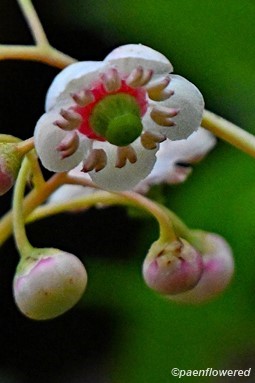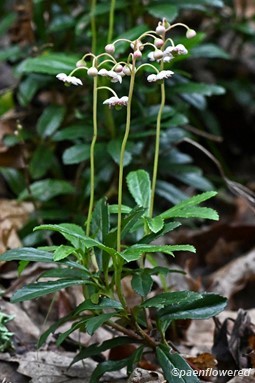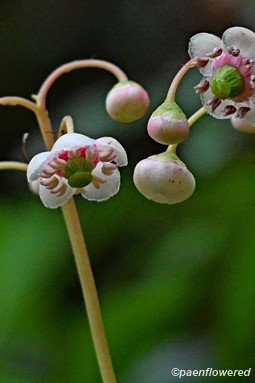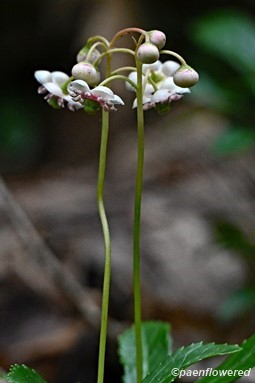Chimaphila umbellata
Chimaphila umbellata pipsissewa
Add to MyPlants View Locations
Pipsissewa is a small evergreen subshrub native to coniferous and mixed woodlands of North America, Europe, and northern Asia. It grows slowly by extending slender, woody stems that root at nodes, forming low clonal mats. Plants are most often found in dry, sandy, or rocky soils under partial to full shade, especially in coniferous and mixed woodlands.
Leaves are evergreen, glossy, and leathery, arranged opposite or in whorls of 3–8. They are lance-shaped to elliptic, 1¼–2 in. long and ⅓–¾ in. wide, with sharply toothed edges. Lower leaves are smaller and nearly oval, while upper leaves are more elongated. Leaves persist for several years, often with old foliage remaining beneath newer growth.
Pipsissewa's stems are woody, slender, and unbranched on flowering shoots. Each year’s growth produces 3–4 new branches, which may root to expand colonies.
Inflorescences are loose terminal clusters of 4–8 nodding flowers borne on slender stalks well above the upper leaves. Each flower is ½–¾″ across, with 5 thick waxy petals, usually white but sometimes pink to red at the base. Petals spread outward like an umbrella around a plump green pistil, surrounded by 10 prominent reddish anthers. Flowers are cup-shaped with rounded tips, and they bloom in midsummer.
The fruit is a dry, 5-parted capsule about ¼″ in diameter, initially green, turning pink, and then maturing to dark brown. Capsules are topped with a distinct button-like stigma and persist through winter, splitting open to release many small seeds.
Habitat & Range
Occasional in upland woods or barrnes in dry, well-drained sandy or rocky soils, most often in coniferous or mixed forests, as well as on forest edges and along roadsides. Prefers partial to full shade.
Scattered troughout the state. See distribution map at BONAP.
Range: Widely distributed across the cool temperate forests of the Northern Hemisphere, including the northern United States, southern Canada, and much of Eurasia
Wetland Code: Not classified
Phenology
Flowers late June through July.
Characteristics
Inflorescence loose terminal cluster (corymb) of 4–8 nodding flowers on slender stalks, above upper leaves
Flowers ½–¾″ across; 5 thick waxy petals (white to pink, often reddish at base), spreading outward around a plump green pistil and 10 reddish anthers
Leaves evergreen, glossy, leathery; 1¼–2″ long, ⅓–¾″ wide; lance-shaped to elliptic with sharply toothed margins; arranged opposite to scattered or in near whorls of 3–8
Stems slender, woody, unbranched flowering shoots; spread by rooting at stem nodes to form colonies
Rhizomes underground, woody; several new shoots per year emerge from nodes
Fruit dry 5-parted capsule about ¼″ across; green → pink → brown; capped with persistent stigma; splits in winter to release small seeds
Height 3–11″
Identification Tips
Low evergreen subshrub with glossy, dark green leaves arranged in near whorls or opposite pairs.
Leaves have sharp teeth along the edges, without the white midrib stripe or occasional white spots seen in C. maculata (striped wintergreen).
Nodding flowers in midsummer, white to pink, with spreading petals around a plump green pistil and reddish anthers.
Dry capsules with button-like caps persist into winter.
Plant Codes
S-rank: No rank
G-rank: G5 (Secure)
Ecology
Flowers are pollinated primarily by bees, which visit for nectar and pollen.
The plant grows in small patches and, like other Chimaphila species, requires a symbiotic relationship with soil fungi for seed germination and establishment.
Chimaphila umbellata pipsissewa
Synonyms: Chimaphila umbellata var. cisatlanticaAdd to MyPlants View Locations






Comments
Have you spotted this plant in your area? We'd love to hear about your experience! Share your comments or questions about the plant below. Comments are moderated before posting.